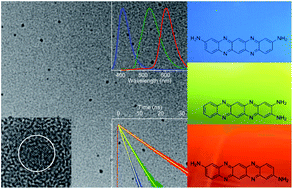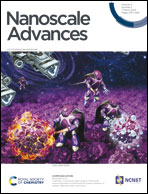Distinctive optical transitions of tunable multicolor carbon dots†
Abstract
Three types of carbon dots (CDs) are synthesized from isomers of phenylenediamine to develop multicolor nanomaterials with low toxicity, high stability, and high quantum yield. The distinctive electronic structures of CDs lead to the characteristic optical transitions, such as three colors of blue, green, and red, which are primarily attributed to the difference in configurations, despite the similar basic structures of conjugated systems. The excitation-independent emission and the single exponential decay of CDs indicate the single chromophore-like nature in each type of CD. In addition, the two-photon luminescence of CDs exhibits a comparable shape and time profile to the typical photoluminescence with high photostability. Although the surface-related defect states are observed by intragap excitation, the contribution of defect states is barely observed in the emission profile upon band gap excitation. Consequently, the controllability of optical transitions in CDs enhances the potential of tunable multicolor nanomaterials for various applications as alternatives to quantum dots containing toxic elements.



 Please wait while we load your content...
Please wait while we load your content...